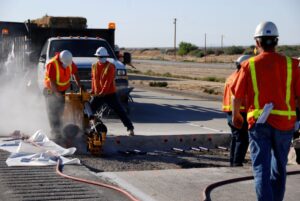Back to Basics is a weekly feature that highlights important but possibly overlooked information that any EHS professional should know. This week, we examine how to maintain safety in a highway construction work zone.
Highway and street construction workers face the risk of fatal and serious injury while on jobsites from passing motor vehicles, the movement of construction vehicles, and equipment.
According to the National Work Zone Safety Information Clearinghouse, there were an estimated 96,000 total work zone crashes in 2022, 37,000 estimated work zone injuries, 891 total work zone fatalities, 282 commercial motor vehicle-involved fatalities, and 136 pedestrian fatalities in work zones. The number of fatal worker injuries at work construction sites was 94 in 2022, down from a high of 143 in 2016.
The types of events resulting in highway worker fatalities at road construction sites, 2020-2022 average, were workers on foot struck by vehicles (51.7%), workers driving or riding in a motor vehicle (26.3%), and other (which includes falls, slips, trips, electrocutions, caught in/between objects or equipment, etc.) (21.9%).
Worker awareness
Road workers need to be aware of their surroundings and the many variables that can lead to an accident. To do so is challenging even when the worker is refreshed and focused, but even more difficult when the worker is drowsy or distracted. Working while tired can be as dangerous as working while intoxicated, according to the Clearinghouse. With more work done at night or on weekend shifts, the potential for worker fatigue grows.
Distractions can also lessen risk awareness on the job, with cell phones being a major source of distraction. Most agencies prohibit the use of personal devices while working, an increasing number of equipment and work tasks involve workers using these devices for work duties. Using these devices can reduce work accuracy and increase reaction times.
The Clearinghouse offers a white paper about maintaining worker situational awareness that is available for download.
Other ways to improve worker safety include minimizing night work hazards. For workers, it’s important to compensate for the effect night work will have on their bodies by maintaining healthy eating and sleeping habits.
Workers should also take extra precautions at the work site when doing night work. To increase visibility, workers should:
- Wear retro-reflective clothing, which appears to light up when illuminated by headlights.
- Wear flashing lights on your body or clothing.
- Put retro-reflective tape on equipment.
- Use good work area lighting.
To know their surroundings, workers should:
- Know the vehicle and equipment paths.
- Know the assigned work areas.
- Know the safe paths to and from work.
- On foot, watch out for equipment.
- On equipment, watch out for workers.
Every April, National Work Zone Awareness Week is held at the start of construction season to encourage safe driving through highway work zones. As part of this year’s event, the Occupational Safety & Health Administration and the Georgia Struck-By Alliance provided work zone safety tips.
MUTCD
The Manual on Uniform Traffic Control Devices for Streets and Highways (MUTCD) defines the standards used by road managers nationwide to install and maintain traffic control devices on all streets, highways, pedestrian and bicycle facilities, and site roadways open to public travel.
It is published by the Federal Highway Administration and compiles national standards for all traffic control devices, including road markings, highway signs, and traffic signals. The 11th Edition of the MUTCD was published in the Federal Register in December 2023 and was effective January 18, 2024. States must adopt the 11th edition as their legal state standard for traffic control devices within two years of the effective date.
Measures to prevent injuries
Researchers from the National Institute for Occupational Safety and Health (NIOSH) published a 2001 report that listed measures to prevent worker injuries from vehicles and equipment. The challenges facing construction contractors, contracting agencies, and others responsible for work zone safety include providing a safe workplace while ensuring the safe movement of the public through the work zone.
The injury prevention measures outlined in the report include:
- Work zone layout
- Use of temporary traffic control devices
- Motorist education and speed enforcement
- Flaggers
- High-visibility apparel
- Illumination of the work zone
- Developing internal traffic control plans
- Implementing internal traffic control plans
- Accountability and coordination at the work site
- Equipment operation and maintenance
- Safe equipment operation around workers on foot
- Training and certification
- Changes in the contracting process
- Laboratory and field research needs
- Data and recordkeeping

